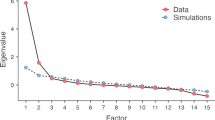Abstract
Child care agencies in Ohio were surveyed concerning their programs and child care workers so as to better understand factors that contribute to job stress, attrition, and satisfaction. The survey provided data regarding the population served at the agencies and the characteristics of child care workers, their services, concerns, desires, and rewards. The findings indicate that environmental variables contribute largely to perceived concern and desired changes, whereas success with children provides a prominent source of job satisfaction.
Similar content being viewed by others
References
Adams, D.W. (1975). Tired and frustrated teachers.Today's Education, 64, 37–41.
Chermiss, C. (1980).Professional burnout in human service organizations: Job stress and the loss of commitment in the noice. New York: Praeger.
Cook-Hatala, C., & Kingsley, R. (1981). Child care workers: an examination of current status. Unpublished study, Kent State University.
Freudenberg, H.J. (1977). Burnout: Occupational hazard of the child care worker.Child Care, 6, 90–99.
Goren, S., & Thieband, C. (1980). Professional burnout.CEC, Chapterpact, Reston, VA: Council for Exceptional Children.
Greenberg, S.F., & Valletulli, P.J. (1980).Stress and the helping profession. Baltimore, MD: Paul H. Brooks.
Huntze, S., & Grosenick, J.R. (1980).National need analysis in behavior disorders. Columbia, MO: Department of Special Education, University of Missouri.
Hylton, L.F. (1964).The residential treatment center: Children, program, costs. New York: Child Welfare League of America.
Lawler, E.E., & Porter, L.W. (1967). The effect of performance on job satisfaction.Industrial Relations, 7, 20–28.
Lawrenson, G., & McKinnon, A. A survey of classroom teachers of the emotionally disturbed: Attrition and burnout factors.Behavior Disorders, 81(1), 41–49.
Maslach, C., & Jackson, S. (1979). Burnout-crops and their families.Psychology Today, 12, 29–82.
Milofsky, C. (1974). Why special education isn't special.Harvard Education Review, 44, 437–458.
Pines, H., & Kafry, D. (1978). Occupation tedium in the social services.Social Work, 23, 499–507.
Sergiovanni, T.J. (1967). Factors that affect satisfaction and dissatisfaction of teachers.Journal of Educational Administration, 5, 56–82.
Spreat, S. (1987). Impact of a modular play unit on staff behavior.Child and Youth Quarterly, 16(1), 68–72.
Toigo, B.R. (1975). Child care manpower development: A literature review.Child Care, 4, 6–17.
Weiskopf, P.E. (1980). Burnout among teachers of exceptional children.Exceptional Children, 47, 18–23.
Zabel, R.H., & Zabel, M.K. (1980). Burnout: A critical issue for educators.Education Unlimited, 2, 23–25.
Author information
Authors and Affiliations
Rights and permissions
About this article
Cite this article
Kingsley, R.F., Cook-Hatala, C. A survey of child care workers: Implications for administrators regarding job stress and satisfaction. Child Youth Care Forum 17, 281–287 (1988). https://doi.org/10.1007/BF01083909
Issue Date:
DOI: https://doi.org/10.1007/BF01083909




